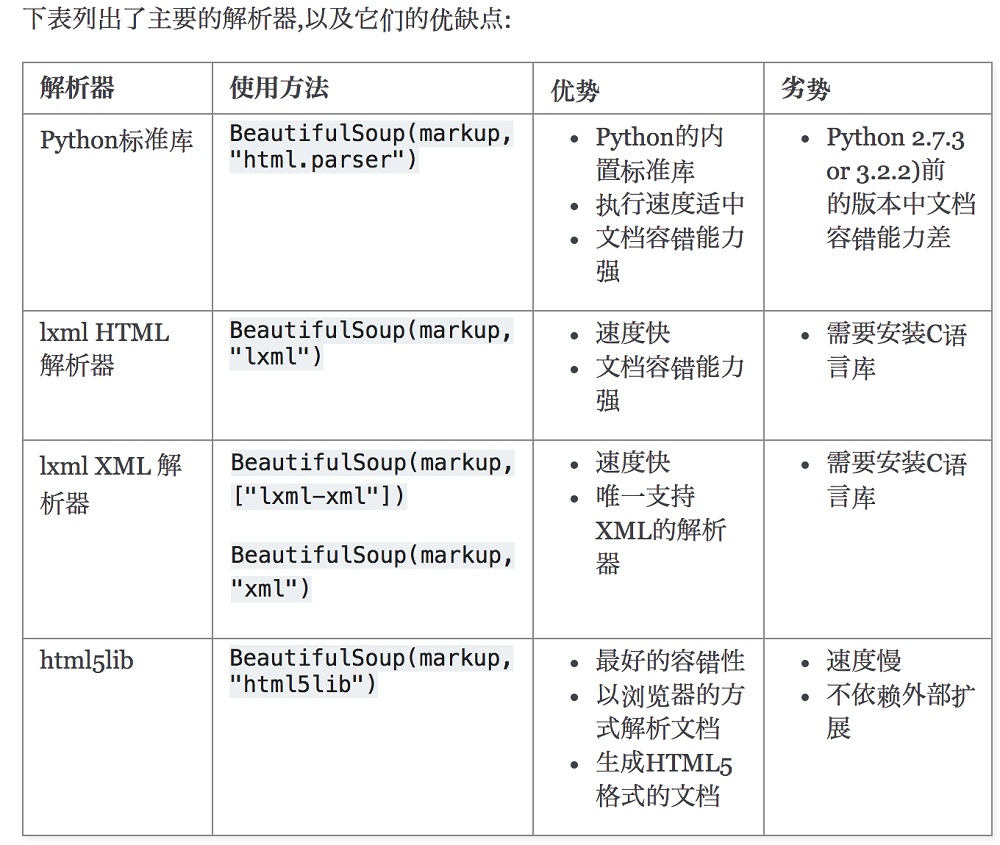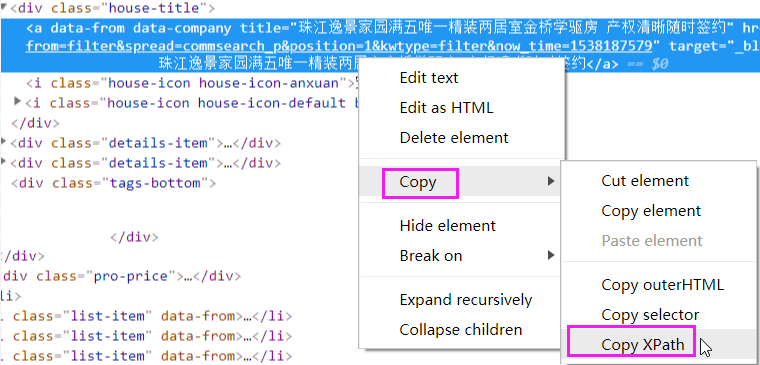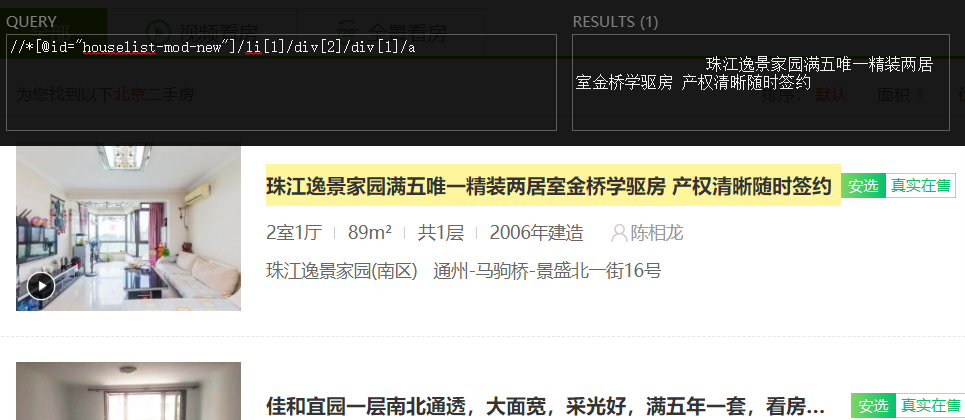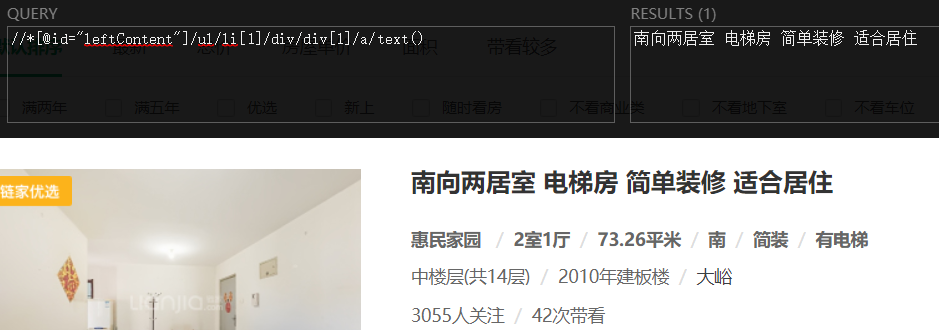一、BeautifulSoup
1. 简介
简单来说,Beautiful Soup是python的一个库,最主要的功能是从网页抓取数据。官方解释如下:
'''Beautiful Soup提供一些简单的、python式的函数用来处理导航、搜索、修改分析树等功能。它是一个工具箱,通过解析文档为用户提供需要抓取的数据,因为简单,所以不需要多少代码就可以写出一个完整的应用程序。'''
Beautiful Soup 是一个可以从HTML或XML文件中提取数据的Python库.它能够通过你喜欢的转换器实现惯用的文档导航,查找,修改文档的方式.Beautiful Soup会帮你节省数小时甚至数天的工作时间.你可能在寻找 Beautiful Soup3 的文档,Beautiful Soup 3 目前已经停止开发,官网推荐在现在的项目中使用Beautiful Soup 4。
安装
pip3 install bs4
解析器
pip3 install lxml
另一个可供选择的解析器是纯Python实现的 html5lib , html5lib的解析方式与浏览器相同,可以选择下列方法来安装html5lib:
pip install html5lib
解析器对比:

简单使用
下面的一段HTML代码将作为例子被多次用到.这是 爱丽丝梦游仙境的 的一段内容(以后内容中简称为 爱丽丝 的文档):
html_doc = """<html><head><title>The Dormouse's story</title></head><body><p class="title"><b>The Dormouse's story</b></p><p class="story">Once upon a time there were three little sisters; and their names were<a href="http://example.com/elsie" class="sister" id="link1">Elsie</a>,<a href="http://example.com/lacie" class="sister" id="link2">Lacie</a> and<a href="http://example.com/tillie" class="sister" id="link3">Tillie</a>;and they lived at the bottom of a well.</p><p class="story">...</p>"""
上面这段代码不是完整的html标签,为什么呢?它没有body和html的结束标签!
没关系,bs4有容错机制!
使用BeautifulSoup解析这段代码,能够得到一个 BeautifulSoup 的对象
from bs4 import BeautifulSoupsoup = BeautifulSoup(html_doc, 'html.parser')
从文档中找到所有标签的链接:
for link in soup.find_all('a'):print(link.get('href'))
执行输出:
http://example.com/elsiehttp://example.com/laciehttp://example.com/tillie
从文档中获取所有文字内容:
print(soup.get_text())
执行输出:
The Dormouse's storyThe Dormouse's storyOnce upon a time there were three little sisters; and their names wereElsie,Lacie andTillie;and they lived at the bottom of a well....
2. 标签对象
通俗点讲就是 HTML 中的一个个标签,Tag 对象与XML或HTML原生文档中的tag相同:
from bs4 import BeautifulSoupsoup = BeautifulSoup('<b class="boldest">Extremely bold</b>','html.parser')tag = soup.bprint(type(tag))
执行输出:
Tag的名字
soup对象再以爱丽丝梦游仙境的html_doc为例,操作文档树最简单的方法就是告诉它你想获取的tag的name.如果想获取 标签,只要用 soup.head :
from bs4 import BeautifulSoupsoup = BeautifulSoup(html_doc, 'html.parser')soup = soup.head # 获取head标签print(soup)soup = soup.title # 获取title标签print(soup)
执行输出:
<head><title>The Dormouse's story</title></head><title>The Dormouse's story</title>
这是个获取tag的小窍门,可以在文档树的tag中多次调用这个方法.下面的代码可以获取标签中的第一个标签:
soup = soup.body.b # <body>标签中的第一个<b>标签print(soup) # <b>The Dormouse's story</b>
通过点取属性的方式只能获得当前名字的第一个tag:
soup = soup.a # 第一个a标签print(soup)# <a class="sister" href="http://example.com/elsie" id="link1">Elsie</a>
如果想要得到所有的标签,或是通过名字得到比一个tag更多的内容的时候,就需要用到 Searching the tree 中描述的方法,比如: find_all()
soup = soup.find_all('a') # 所有a标签print(soup)
执行输出:
[<a class="sister" href="http://example.com/elsie" id="link1">Elsie</a>,<a class="sister" href="http://example.com/lacie" id="link2">Lacie</a>,<a class="sister" href="http://example.com/tillie" id="link3">Tillie</a>]
结果是一个列表!
我们可以利用 soup加标签名轻松地获取这些标签的内容,注意,它查找的是在所有内容中的第一个符合要求的标签。
Tag的name和attributes属性
Tag有很多方法和属性,主要是 标签对象的名称,属性,文本。
现在介绍一下tag中最重要的属性: name和attributes
名称和属性
每个tag都有自己的名字,通过.name 来获取:
from bs4 import BeautifulSoupsoup = BeautifulSoup(html_doc, 'html.parser')soup = soup.find_all('a') # 所有a标签for link in soup:print(link.name) # 标签名print(link.get('id')) # id属性print(link.get('class')) # class属性print(link.get('href')) # herf属性print(link.attrs) # 标签所有属性# {'href': 'http://example.com/tillie', 'class': ['sister'], 'id': 'link3'}
tag的属性可以被添加,删除或修改. 再说一次, tag的属性操作方法与字典一样
修改
from bs4 import BeautifulSoupsoup = BeautifulSoup(html_doc, 'html.parser')soup = soup.find_all('a') # 所有a标签soup[0]['class'] = 'verybold' # 修改class属性soup[0]['id'] = 1 # 修改id属性print(soup[0])# <a class="verybold" href="http://example.com/elsie" id="1">Elsie</a>
删除
soup = soup.find_all('a') # 所有a标签del soup[0]['class']del soup[0]['id']print(soup[0])# <a href="http://example.com/elsie">Elsie</a>
文本获取
标签对象的文本获取
from bs4 import BeautifulSoupsoup = BeautifulSoup(html_doc, 'html.parser')print(soup.p.string) # p下的文本只有一个时,取到,否则为Noneprint(soup.p.strings) # 拿到一个生成器对象, 取到p下所有的文本内容print(soup.p.text) #取到p下所有的文本内容for line in soup.stripped_strings: #去掉空白print(line)
执行输出:
The Dormouse's story<generator object _all_strings at 0x000001AA3941C5C8>The Dormouse's storyThe Dormouse's storyThe Dormouse's storyOnce upon a time there were three little sisters; and their names wereElsie,LacieandTillie;and they lived at the bottom of a well....
如果tag包含了多个子节点,tag就无法确定 .string 方法应该调用哪个子节点的内容, .string 的输出结果是 None,如果只有一个子节点那么就输出该子节点的文本,比如下面的这种结构,soup.p.string 返回为None,但soup.p.strings就可以找到所有文本
from bs4 import BeautifulSouptmp_html= """<p id='list-1'>哈哈哈哈<a class='sss'><span><h1>aaaa</h1></span></a><b>bbbbb</b></p>"""soup = BeautifulSoup(tmp_html, 'html.parser')print(soup.p.string) # p下的文本只有一个时,取到,否则为Noneprint(soup.p.strings) # 拿到一个生成器对象, 取到p下所有的文本内容for i in soup.stripped_strings:print('-->',i)
执行输出:
None<generator object _all_strings at 0x000002017427C570>--> 哈哈哈哈--> aaaa--> bbbbb
因此,使用 string,标签下的文本只能有一个,否则返回None!
而使用text,返回所有文本!
这就是tag.text和tag.string的区别!
3.遍历文档树
关于DOM数,请参考链接:
https://www.cnblogs.com/majj/p/9102890.html
1、嵌套选择
from bs4 import BeautifulSoupsoup = BeautifulSoup(html_doc, 'html.parser')print(soup.head.title.string) # The Dormouse's storyprint(soup.body.a.string) # Elsie
2、子节点、子孙节点
from bs4 import BeautifulSoupsoup = BeautifulSoup(html_doc, 'html.parser')print(soup.p.contents) #p下所有子节点print(soup.p.children) #得到一个迭代器,包含p下所有子节点for i,child in enumerate(soup.p.children):print(i,child)print(soup.p.descendants) #获取子孙节点,p下所有的标签都会选择出来for i,child in enumerate(soup.p.descendants):print(i,child)
3、父节点、祖先节点
print(soup.a.parent) #获取a标签的父节点print(soup.a.parents) #找到a标签所有的祖先节点,父亲的父亲,父亲的父亲的父亲...
soup.a.parents 最终返回的节点是…。也就是说,它直接回到顶层了!
4、兄弟节点
print('=====>')print(soup.a.next_sibling) #下一个兄弟print(soup.a.previous_sibling) #上一个兄弟print(list(soup.a.next_siblings)) #下面的兄弟们=>生成器对象print(soup.a.previous_siblings) #上面的兄弟们=>生成器对象
4. 搜索文档树
BeautifulSoup定义了很多搜索方法,这里着重介绍2个: find() 和 find_all() .其它方法的参数和用法类似
1、五种过滤器
搜索文档树:BeautifulSoup定义了很多搜索方法,这里着重介绍2个: find() 和 find_all() .其它方法的参数和用法类似
html_doc = """<html><head><title>The Dormouse's story</title></head><body><p id="my p" class="title"><b id="bbb" class="boldest">The Dormouse's story</b></p><p class="story">Once upon a time there were three little sisters; and their names were<a href="http://example.com/elsie" class="sister" id="link1">Elsie</a>,<a href="http://example.com/lacie" class="sister" id="link2">Lacie</a> and<a href="http://example.com/tillie" class="sister" id="link3">Tillie</a>;and they lived at the bottom of a well.</p><p class="story">...</p>"""from bs4 import BeautifulSoupsoup=BeautifulSoup(html_doc,'lxml')
五种过滤器: 字符串、正则表达式、列表、True、方法
1.1、字符串:即标签名
print(soup.find_all('b'))
执行输出:
[<b class="boldest" id="bbb">The Dormouse's story</b>]
1.2、正则表达式
import reprint(soup.find_all(re.compile('^b'))) #找出b开头的标签,结果有body和b标签
执行输出:
[<body><p class="title" id="my p"><b class="boldest" id="bbb">The Dormouse's story</b></p><p class="story">Once upon a time there were three little sisters; and their names were<a class="sister" href="http://example.com/elsie" id="link1">Elsie</a>,<a class="sister" href="http://example.com/lacie" id="link2">Lacie</a> and<a class="sister" href="http://example.com/tillie" id="link3">Tillie</a>;and they lived at the bottom of a well.</p><p class="story">...</p></body>, <b class="boldest" id="bbb">The Dormouse's story</b>]
1.3、列表
如果传入列表参数,Beautiful Soup会将与列表中任一元素匹配的内容返回.下面代码找到文档中所有标签和标签:
print(soup.find_all(['a','b']))
执行输出:
[<b class="boldest" id="bbb">The Dormouse's story</b>, <a class="sister" href="http://example.com/elsie" id="link1">Elsie</a>, <a class="sister" href="http://example.com/lacie" id="link2">Lacie</a>, <a class="sister" href="http://example.com/tillie" id="link3">Tillie</a>]
1.4、True
可以匹配任何值,下面代码查找到所有的tag,但是不会返回字符串节点
print(soup.find_all(True))for tag in soup.find_all(True):print(tag.name)
这个不怎么用,可以忽略掉!
1.5、方法
如果没有合适过滤器,那么还可以定义一个方法,方法只接受一个元素参数 ,如果这个方法返回 True 表示当前元素匹配并且被找到,如果不是则反回 False
from bs4 import BeautifulSoupsoup=BeautifulSoup(html_doc,'lxml')def has_class_but_no_id(tag): # 有class但是没有id属性的标签return tag.has_attr('class') and not tag.has_attr('id')print(soup.find_all(has_class_but_no_id)) # 将每一个标签传给这个方法过滤
执行输出:
[<p class="story">Once upon a time there were three little sisters; and their names were<a class="sister" href="http://example.com/elsie" id="link1">Elsie</a>,<a class="sister" href="http://example.com/lacie" id="link2">Lacie</a> and<a class="sister" href="http://example.com/tillie" id="link3">Tillie</a>;and they lived at the bottom of a well.</p>, <p class="story">...</p>]
最终输出的,都是有class属性,但是没有id属性的标签
2、find_all()
语法
find_all( name , attrs , recursive , text , **kwargs )
2.1、name
搜索name参数的值可以使任一类型的 过滤器 ,字符窜,正则表达式,列表,方法或是 True
from bs4 import BeautifulSoupsoup=BeautifulSoup(html_doc,'lxml')import reprint(soup.find_all(name=re.compile('^t')))
执行输出:
[<title>The Dormouse's story</title>]
2.2、keyword
key=value的形式,value可以是过滤器:字符串 , 正则表达式 , 列表, True
print(soup.find_all(id=re.compile('my'))) # 查找id含有my属性的标签# 查找herf含有lacle以及id带有数字的标签。# 如果是class属性,需要使用class_,因为在python中,class是关键字!print(soup.find_all(href=re.compile('lacie'),id=re.compile('\d')))print(soup.find_all(id=True)) #查找有id属性的标签
执行输出:
[<p class="title" id="my p"><b class="boldest" id="bbb">The Dormouse's story</b></p>][<a class="sister" href="http://example.com/lacie" id="link2">Lacie</a>][<p class="title" id="my p"><b class="boldest" id="bbb">The Dormouse's story</b></p>, <b class="boldest" id="bbb">The Dormouse's story</b>, <a class="sister" href="http://example.com/elsie" id="link1">Elsie</a>, <a class="sister" href="http://example.com/lacie" id="link2">Lacie</a>, <a class="sister" href="http://example.com/tillie" id="link3">Tillie</a>]
有些tag属性在搜索不能使用,比如HTML5中的 data-* 属性:
data_soup = BeautifulSoup('<div data-foo="value">foo!</div>','lxml')data_soup.find_all(data-foo="value") #报错:SyntaxError: keyword can't be an expression
但是可以通过 find_all() 方法的 attrs 参数定义一个字典参数来搜索包含特殊属性的tag:
from bs4 import BeautifulSoupsoup=BeautifulSoup(html_doc,'lxml')data_soup = BeautifulSoup('<div data-foo="value">foo!</div>','lxml')print(data_soup.find_all(attrs={"data-foo": "value"}))# [<div data-foo="value">foo!</div>]
2.3、按照类名查找
注意关键字是class,class=value,value可以是五种选择器之一
from bs4 import BeautifulSoupsoup=BeautifulSoup(html_doc,'lxml')import reprint(soup.find_all('a',class_='sister')) #查找类为sister的a标签print(soup.find_all('a',class_='sister ssss')) #查找类为sister和sss的a标签,顺序错误也匹配不成功print(soup.find_all(class_=re.compile('^sis'))) #查找类为sister的所有标签
执行输出:
[<a class="sister" href="http://example.com/elsie" id="link1">Elsie</a>, <a class="sister" href="http://example.com/lacie" id="link2">Lacie</a>, <a class="sister" href="http://example.com/tillie" id="link3">Tillie</a>][][<a class="sister" href="http://example.com/elsie" id="link1">Elsie</a>, <a class="sister" href="http://example.com/lacie" id="link2">Lacie</a>, <a class="sister" href="http://example.com/tillie" id="link3">Tillie</a>]
2.4、attrs
如果有多个属性,在attrs里面增加key-value即可
# 查询p标签,class属性为storyprint(soup.find_all('p',attrs={'class':'story'}))
执行输出:
[<p class="story">Once upon a time there were three little sisters; and their names were<a class="sister" href="http://example.com/elsie" id="link1">Elsie</a>,<a class="sister" href="http://example.com/lacie" id="link2">Lacie</a> and<a class="sister" href="http://example.com/tillie" id="link3">Tillie</a>;and they lived at the bottom of a well.</p>, <p class="story">...</p>]
2.5、text
值可以是:字符,列表,True,正则
print(soup.find_all(text='Elsie'))print(soup.find_all('a',text='Elsie'))
执行输出:
['Elsie'][<a class="sister" href="http://example.com/elsie" id="link1">Elsie</a>]
2.6、limit参数
如果文档树很大那么搜索会很慢.如果我们不需要全部结果,可以使用 limit 参数限制返回结果的数量.效果与SQL中的limit关键字类似,当搜索到的结果数量达到 limit 的限制时,就停止搜索返回结果
print(soup.find_all('a',limit=2))
执行输出:
[<a class="sister" href="http://example.com/elsie" id="link1">Elsie</a>, <a class="sister" href="http://example.com/lacie" id="link2">Lacie</a>]
2.7、recursive
调用tag的 find_all() 方法时,Beautiful Soup会检索当前tag的所有子孙节点,如果只想搜索tag的直接子节点,可以使用参数 recursive=False
print(soup.html.find_all('a'))print(soup.html.find_all('a',recursive=False))
执行输出:
[<a class="sister" href="http://example.com/elsie" id="link1">Elsie</a>, <a class="sister" href="http://example.com/lacie" id="link2">Lacie</a>, <a class="sister" href="http://example.com/tillie" id="link3">Tillie</a>][]
备注
像调用 find_all() 一样调用tagfind_all() 几乎是Beautiful Soup中最常用的搜索方法,所以我们定义了它的简写方法. BeautifulSoup 对象和 tag 对象可以被当作一个方法来使用,这个方法的执行结果与调用这个对象的 find_all() 方法相同,下面两行代码是等价的:soup.find_all("a")soup("a")这两行代码也是等价的:soup.title.find_all(text=True)soup.title(text=True)
3、find()
语法
find( name , attrs , recursive , text , **kwargs )
find_all() 方法将返回文档中符合条件的所有tag,尽管有时候我们只想得到一个结果.比如文档中只有一个标签,那么使用 find_all() 方法来查找标签就不太合适, 使用 find_all 方法并设置 limit=1 参数不如直接使用 find() 方法.下面两行代码是等价的:
from bs4 import BeautifulSoupsoup=BeautifulSoup(html_doc,'lxml')print(soup.find_all('title', limit=1))# soup.find_all('title', limit=1)print(soup.find('title'))# <title>The Dormouse's story</title>
唯一的区别是 find_all() 方法的返回结果是值包含一个元素的列表,而 find() 方法直接返回结果.
find_all() 方法没有找到目标是返回空列表, find() 方法找不到目标时,返回 None .
print(soup.find("nosuchtag"))# None
soup.head.title 是 tag的名字 方法的简写.这个简写的原理就是多次调用当前tag的 find() 方法:
print(soup.head.title)# <title>The Dormouse's story</title>print(soup.find("head").find("title"))# <title>The Dormouse's story</title>
4、其他方法
见官网: https://www.crummy.com/software/BeautifulSoup/bs4/doc/index.zh.html#find-parents-find-parent
5、css选择器
我们在写 CSS 时,标签名不加任何修饰,类名前加点,id名前加 #,在这里我们也可以利用类似的方法来筛选元素,用到的方法是 soup.select(),返回类型是 list
1. 通过标签名查找
from bs4 import BeautifulSoupsoup=BeautifulSoup(html_doc,'lxml')print(soup.select("title")) # [<title>The Dormouse's story</title>]print(soup.select("b")) # [<b class="boldest" id="bbb">The Dormouse's story</b>]
2. 通过类名查找
print(soup.select(".sister"))'''[<a class="sister" href="http://example.com/elsie" id="link1">Elsie</a>,<a class="sister" href="http://example.com/lacie" id="link2">Lacie</a>,<a class="sister" href="http://example.com/tillie" id="link3">Tillie</a>]'''
3. 通过 id 名查找
print(soup.select("#link1"))# [<a class="sister" href="http://example.com/elsie" id="link1">Elsie</a>]
4. 组合查找
组合查找即和写 class 文件时,标签名与类名、id名进行的组合原理是一样的,例如查找 p 标签中,id 等于 link1的内容,二者需要用空格分开
print(soup.select("p #link2"))#[<a class="sister" href="http://example.com/lacie" id="link2">Lacie</a>]
直接子标签查找
print(soup.select("p > #link2"))# [<a class="sister" href="http://example.com/lacie" id="link2">Lacie</a>]
5. 属性查找
查找时还可以加入属性元素,属性需要用中括号括起来,注意属性和标签属于同一节点,所以中间不能加空格,否则会无法匹配到。
print(soup.select("a[href='http://example.com/tillie']"))#[<a class="sister" href="http://example.com/tillie" id="link3">Tillie</a>]
select 方法返回的结果都是列表形式,可以遍历形式输出,然后用 get_text() 方法来获取它的内容:
for title in soup.select('a'):print (title.get_text())'''ElsieLacieTillie'''
5. 修改文档树
二、Xpath模块
xpath简介
XPath在Python的爬虫学习中,起着举足轻重的地位,对比正则表达式 re两者可以完成同样的工作,实现的功能也差不多,但XPath明显比re具有优势,在网页分析上使re退居二线。
XPath介绍
是什么? 全称为XML Path Language 一种小型的查询语言
说道XPath是门语言,不得不说它所具备的优点:
- 可在XML中查找信息
- 支持HTML的查找 通
- 过元素和属性进行导航
python开发使用XPath条件: 由于XPath属于lxml库模块,所以首先要安装库lxml。
XPath的简单调用方法:
from lxml import etreeselector=etree.HTML(源码) #将源码转化为能被XPath匹配的格式selector.xpath(表达式) #返回为一列表
Xpath语法
查询
html_doc = """<!DOCTYPE html><html lang="en"><head><meta charset="UTF-8"><title>Title</title></head><body><div class="d1"><div class="d2"><p class="story"><a href="http://example.com/elsie" class="sister" id="link1">Elsie</a>,<a href="http://example.com/lacie" class="sister" id="link2">Lacie</a> and<a href="http://example.com/tillie" id="link3">Tillie</a></p></div><div><p id="p1">ALex is dsb</p><p id="p2">Egon too</p></div></div><div class="d3"><a href="http://www.baidu.com">baidu</a><p>百度</p></div></body></html>"""from lxml import etreeselector=etree.HTML(html_doc) # 将源码转化为能被XPath匹配的格式
1. 选取节点
语法:
nodename 选取nodename节点的所有子节点 xpath(‘//div’) 选取了所有div节点/ 从根节点选取 xpath(‘/div’) 从根节点上选取div节点// 选取所有的当前节点,不考虑他们的位置 xpath(‘//div’) 选取所有的div节点. 选取当前节点 xpath(‘./div’) 选取当前节点下的div节点.. 选取当前节点的父节点 xpath(‘..’) 回到上一个节点@ 选取属性 xpath(’//@calss’) 选取所有的class属性
示例代码:
ret=selector.xpath("//div")ret=selector.xpath("/div")ret=selector.xpath("./div")ret=selector.xpath("//p[@id='p1']")ret=selector.xpath("//div[@class='d1']/div/p[@class='story']")
2. 谓语
语法:
表达式 结果xpath(‘/body/div[1]’) 选取body下的第一个div节点xpath(‘/body/div[last()]’) 选取body下最后一个div节点xpath(‘/body/div[last()-1]’) 选取body下倒数第二个div节点xpath(‘/body/div[positon()<3]’) 选取body下前两个div节点xpath(‘/body/div[@class]’) 选取body下带有class属性的div节点xpath(‘/body/div[@class=”main”]’) 选取body下class属性为main的div节点xpath(‘/body/div[price>35.00]’) 选取body下price元素值大于35的div节点
示例代码:
from lxml import etreeselector=etree.HTML(html_doc) # 将源码转化为能被XPath匹配的格式ret=selector.xpath("//p[@class='story']//a[2]") # [<Element a at 0x20d9a188c88>]ret=selector.xpath("//p[@class='story']//a[last()]") # [<Element a at 0x27a64818d88>]
返回结果是一个Element对象
3. 通配符
Xpath通过通配符来选取未知的XML元素
表达式 结果xpath(’/div/*’) 选取div下的所有子节点xpath(‘/div[@*]’) 选取所有带属性的div节点
示例代码:
ret=selector.xpath("//p[@class='story']/*")# [<Element a at 0x22c8461bcc8>, <Element a at 0x22c8461bc88>, <Element a at 0x22c8461bd88>]ret=selector.xpath("//p[@class='story']/a[@class]") # [<Element a at 0x1ebe370bc88>, <Element a at 0x1ebe370bd88>]
4. 取多个路径
使用“|”运算符可以选取多个路径
表达式 结果xpath(‘//div|//table’) 选取所有的div和table节点
示例代码:
ret=selector.xpath("//p[@class='story']/a[@class]|//div[@class='d3']")print(ret)# [<Element a at 0x1d509bd9cc8>, <Element a at 0x1d509bd9c88>, <Element div at 0x1d509bd9d88>]
5. Xpath轴
轴可以定义相对于当前节点的节点集
轴名称 表达式 描述ancestor xpath(‘./ancestor::*’) 选取当前节点的所有先辈节点(父、祖父)ancestor-or-self xpath(‘./ancestor-or-self::*’) 选取当前节点的所有先辈节点以及节点本身attribute xpath(‘./attribute::*’) 选取当前节点的所有属性child xpath(‘./child::*’) 返回当前节点的所有子节点descendant xpath(‘./descendant::*’) 返回当前节点的所有后代节点(子节点、孙节点)following xpath(‘./following::*’) 选取文档中当前节点结束标签后的所有节点following-sibing xpath(‘./following-sibing::*’) 选取当前节点之后的兄弟节点parent xpath(‘./parent::*’) 选取当前节点的父节点preceding xpath(‘./preceding::*’) 选取文档中当前节点开始标签前的所有节点preceding-sibling xpath(‘./preceding-sibling::*’) 选取当前节点之前的兄弟节点self xpath(‘./self::*’) 选取当前节点
6. 功能函数
使用功能函数能够更好的进行模糊搜索
函数 用法 解释starts-with xpath(‘//div[starts-with(@id,”ma”)]‘) 选取id值以ma开头的div节点contains xpath(‘//div[contains(@id,”ma”)]‘) 选取id值包含ma的div节点and xpath(‘//div[contains(@id,”ma”) and contains(@id,”in”)]‘) 选取id值包含ma和in的div节点text() xpath(‘//div[contains(text(),”ma”)]‘) 选取节点文本包含ma的div节点
举例1:
# 选取p标签class属性为story,在它下面的a标签id属性为link1的文本信息ret=selector.xpath("//p[@class='story']/a[@id='link1']/text()")print(ret) # ['Elsie']
举例2:
# 选取p标签class属性为story,在它下面的a标签id属性以link开头的文本信息ret=selector.xpath("//p[@class='story']/a[starts-with(@id,'link')]/text()")print(ret) # ['Elsie', 'Lacie', 'Tillie']
举例3:
# 选取p标签class属性为story,在它下面的a标签id属性包含k的文本信息ret=selector.xpath("//p[@class='story']/a[contains(@id,'k')]/text()")print(ret) # ['Elsie', 'Lacie', 'Tillie']
举例4:
# 选取p标签class属性为story,在它下面的a标签class属性包含is的文本信息ret=selector.xpath("//p[@class='story']/a[contains(@class,'is')]/text()")print(ret) # ['Elsie', 'Lacie']
举例5:
# 选取p标签class属性为story,在它下面的a标签文本信息包含ie的文本信息ret=selector.xpath("//p[@class='story']/a[contains(text(),'ie')]/text()")print(ret) # ['Elsie', 'Lacie', 'Tillie']
Element对象
from lxml.etree import _Elementfor obj in ret:print(obj)print(type(obj)) # from lxml.etree import _Element'''Element对象class xml.etree.ElementTree.Element(tag, attrib={}, **extra)tag:string,元素代表的数据种类。text:string,元素的内容。tail:string,元素的尾形。attrib:dictionary,元素的属性字典。#针对属性的操作clear():清空元素的后代、属性、text和tail也设置为None。get(key, default=None):获取key对应的属性值,如该属性不存在则返回default值。items():根据属性字典返回一个列表,列表元素为(key, value)。keys():返回包含所有元素属性键的列表。set(key, value):设置新的属性键与值。#针对后代的操作append(subelement):添加直系子元素。extend(subelements):增加一串元素对象作为子元素。#python2.7新特性find(match):寻找第一个匹配子元素,匹配对象可以为tag或path。findall(match):寻找所有匹配子元素,匹配对象可以为tag或path。findtext(match):寻找第一个匹配子元素,返回其text值。匹配对象可以为tag或path。insert(index, element):在指定位置插入子元素。iter(tag=None):生成遍历当前元素所有后代或者给定tag的后代的迭代器。#python2.7新特性iterfind(match):根据tag或path查找所有的后代。itertext():遍历所有后代并返回text值。remove(subelement):删除子元素。'''
本文参考链接:
https://www.cnblogs.com/yuanchenqi/articles/9487175.html
应用案例:安居客
打开安居客二手房链接:
https://beijing.anjuke.com/sale/?from=navigation
需要爬取 标题

务必使用谷歌浏览器打开,右键检查。找到对应的标签,右键copy—>copy Xpath

那么就能得到
//*[@id="leftContent"]/ul/li[1]/div/div[1]/a
接下来写代码:
import requestsfrom lxml import etree# 访问二手房网页res= requests.get("https://beijing.anjuke.com/sale/?from=navigation")selector=etree.HTML(res.content) # 将html源码转化为能被XPath匹配的格式# 匹配第一个条信息的标题ret=selector.xpath('//*[@id="houselist-mod-new"]/li[1]/div[2]/div[1]/a/text()')print(ret)
执行输出:
['\n 凤凰城二期,高层两居室,看房有钥匙随时,临国际村,金星园澜石']
怎么样,是不是很方便。注意:它能帮你快速生成 XPath表达式。它并不是万能的,在某些动态加载的网页中,可能不适用!
上面的结果只有一条,如果有多条呢?需要自己修改规则了!
XPath Helper
XPath Helper可以支持在网页点击元素生成xpath,整个抓取使用了xpath、正则表达式、消息中间件、多线程调度框架的chrome插件。
这里我已经安装好了

安装完成之后,在页面右上角,有一个图标

点击一下,它会弹出一个黑框。将刚才的XPath规则复制到左边,右边会立即显示结果
如果被选中,页面会有黄色标记!

作业:
爬取链家二手房信息,爬取3页即可!
注意:使用XPath完成!
分解步骤
打开链接二手房链接:
https://bj.lianjia.com/ershoufang/
获取标题
获取第一条信息的标题

选择所有信息中的标题部分

使用python代码实现
import requestsfrom lxml import etree# 访问二手房网页res= requests.get("https://bj.lianjia.com/ershoufang/")selector=etree.HTML(res.content) # 将html源码转化为能被XPath匹配的格式# 匹配所有的标题ret=selector.xpath('//*[@id="leftContent"]/ul/li[*]//div/div/a/text()')print(ret)
执行输出:
['南向两居室 电梯房 简单装修 适合居住', '惠民家园 ', ...]
那么所有的标题,就获取完成了!

